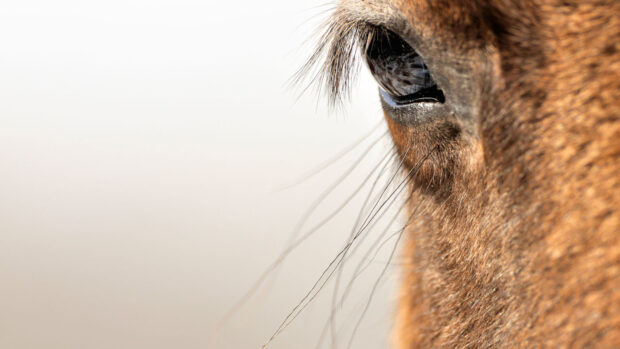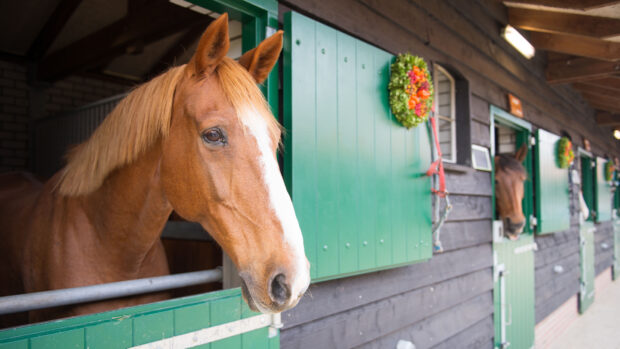When do health problems become emergencies that require urgent veterinary attention? A British Equine Veterinary Association president pinpoints the warning signs
If you suspect that a bone might be involved, either because it is exposed, or because the conformation of the leg looks abnormal, urgent veterinary attention is essential. Large gaping wounds with a lot of blood look dramatic, but smaller puncture wounds can be more problematic.
A vet should examine any wound that is over any joint or the windgall area. If the wound is leaking a clear-yellow sticky fluid, then this is doubly serious. This yellow fluid originates from inside the joint, and if the joint or tendon sheath becomes infected, the horse will need emergency treatment. If there is bone or tendon tissue showing, call the vet immediately.
Call the vet if…
The wound is leaking clear-yellow sticky fluid.
Eye injuries
When there is damage to the surface of the eye or a serious infection takes hold, the inside of the eye responds by becoming inflamed. This is sometimes referred to as secondary uveitis. When horses develop uveitis, the pupil in the affected eye invariably becomes smaller. This is serious.
In summer, watery or runny eyes are commonplace due to flies. These can be monitored to ensure that they do not develop into anything more sinister.
If the eye is painful and the horse is having trouble opening it, you must summon expert assistance. Similarly, look out for the third eyelid (the pink tissue in the inside corner of the eye). If this is always showing it could indicate the presence of a cancerous growth.
Call the vet if…
One pupil is smaller than the other or the eye is partially closed.
Colic
No matter how minor a bout of colic, always call the vet. Horses with colic can deteriorate quickly. Your vet may ask for your horse’s signs — heart rate, temperature and breathing rate — and offer advice over the phone before deciding whether to visit.
If the horse is in visible pain, it needs to be seen by a vet straight away — irrespective of its clinical signs.
Call the vet if…
The horse is in visible pain (but seeking assistance for any suspected colic case is always recommended).
Lameness
A lame horse that hardly puts weight on the leg should be seen by the vet urgently, while a filled leg with no lameness is unlikely to require urgent veterinary attention.
If there are no fresh wounds on the limb or any other signs of trauma, then examine the feet carefully. There are only a few instances where a horse cannot bear weight on a limb. A foot abscess is one, as it causes a build-up of pressure within the hoof. Another cause is “nail bind”, where a farrier’s nail is pinching or touching the sensitive parts of the hoof. Compare the digital pulses in both legs — a higher digital pulse in one foot usually indicates inflammation. Lameness becomes a veterinary issue when your farrier can’t find a source of hoof pain.
Call the vet if…
There is any significant wound in association with lameness or the horse is not bearing weight on a limb.
The pregnant mare
Mares have strong abdominal contractions when they are foaling. Once they are lying down and starting to strain the foal should emerge quickly.
The majority of foalings progress smoothly, but if the mare strains for more than 20min, call your vet. Any delay to foaling usually means there is something wrong with the delivery — the foal may be in breach position, or too large to come out in the normal way.
You must call the vet if foaling is prolonged, or you could lose the foal and the mare.
Call the vet if…
The mare has been down and straining for more than 20min.
Continued below…
Horse owners and vets face difficult decisions everyday. Vet Roger Lee lists the toughest choices an owner will ever have

The 5 most difficult decisions you’ll ever have to make as a horse owner
Choke
Signs of choke include sweating, pain, coughing, retching and excess salivation with food coming down the nose. The condition can be serious and may even result in pneumonia if food is inhaled into the lungs.
Most chokes clear themselves quickly — usually within about 20min. This is because the body does a good job of gradually moistening the food and pushing it towards the stomach. But when this fails to happen, the horse chokes.
If your horse experiences a choke episode, it is vital to remove all food and water and keep him comfortable.
Call the vet if…
The choke episode has not passed within 20min.
Nasal discharge
A small amount of watery or white discharge from the nose is perfectly normal. Thick, foul-smelling yellow discharge is not. But this is not necessarily a veterinary emergency.
Worry when there is persistent blood coming from one or both nostrils. This can be a sign of a rare fungal infection that can erode through the internal carotid artery and cause a serious haemorrhage.
Small spots of blood after exercise, or even a spot of blood on an isolated occasion, is fine — these can be associated with exertion or a head knock — but any bleeding which is unrelenting is an urgent medical emergency.
Call the vet if…
There is persistent or recurring bleeding.
This article was first published in Horse & Hound Ask The Vet (Spring 2012)



